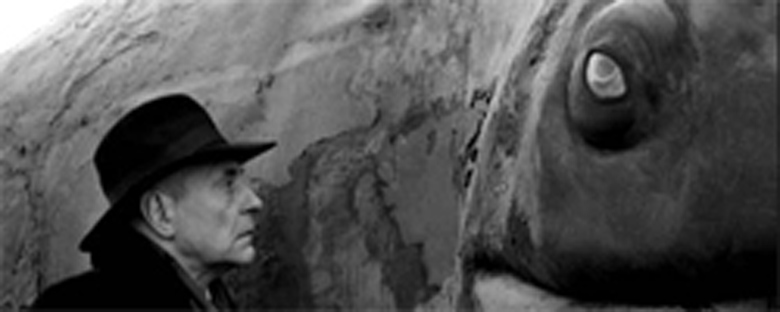Reviews
Werckmeister harmóniák
Béla Tarr
Hungary, 2000
Credits
Review by Rumsey Taylor
Posted on 21 March 2006
Source Facets DVD
Related articles
Reviews: Sátántangó
János arranges the remaining patrons of a rural pub into an abbreviated model of the solar system: the Sun at the center, emitting light throughout; the rotating Earth, and its Moon encircling it. This occurs late in a pitch black night, and János’ wide-eyed enthusiasm instills a sober attention in most everyone present. He shoulders his makeshift satellites into their proper orbits, halting their position suddenly to demonstrate the phenomenon of a solar eclipse. The sun’s warmth is obscured, robbing the earth of its crucial nurture; everyone stands silent and discomforted.
On János’ walk home, he observes the arrival of a gigantic trailer, containing the attractions promised in flyers posted about the town: a preserved whale, and a mysterious figure deemed a prince (his fleeting descriptions make him out to be some sort of sideshow freak). The following morning — the trailer parked in the center of the town square — dozens have surrounded the enclosed trailer, punctuating its space with bonfires and gossip. Its enormous door is cranked open, and János approaches it eager, its first customer. Until the final scene, he is the attraction’s only patron, yet its presence instills great superstition in everyone else.
János’ relationship to the ensuing mob is contradictory: to some, he is an auspice, entrusted to observe the townsfolk and to return with descriptions of their conversation and behavior. But he is also an outsider because he does not support the hasty movement for revolution. Accordingly, when he returns to the square to revisit the whale (at which point the exhibit has been closed) he is met by angry stares in the growing mob.
The attraction inspires a massive revolt (attended only by men, hundreds of them) upon a decrepit hospice. The patients are tossed from their beds and beaten, the men dispersing across the location in silence. They come upon an elder standing in a bathtub, an epitome of vulnerability. (This is filmed in a single, majestically choreographed take, culminating in the revelation of János, who has been spying on the violence.) In a sudden and implicit concurrence, the men exit in a uniform group.
An intense paranoia is exalted, one discerned in the immobile silence of each conspirator, but for what reason? This seems to have been inspired by the whale, but it is curious for the behemoth’s obvious potency as a Biblical icon. More curious is the role of the comparatively diminutive prince, seen only by his shadow, and in only one scene. The prince is not exhibited due to the mutinous attitude discerned in the townsfolk by the exhibitor, but in his speech the prince speaks of his potential for influence, his followers and their desire to see him. What tenets he promotes, how popular he is, what he looks like: none of this is revealed. The film, told in operatic long takes and sudden surges of Mihály Vig’s score, apparently subsists on such ambiguity.
This all occurs at night, reinforcing the metaphoric utility demonstrated in the opening shot. The prohibition of light causes insurgence; aptly, in the first glimpse we afford of the trailer, it is preceded by an enormous shadow that envelops the alleyway ahead of it. The trailer is eventually destroyed, leaving the whale beached and unprotected — in turn, no longer a supernatural threat — in the center of the town square. Its final observer approaches it, and exits before the behemoth is enveloped in fog.
We don’t do comments anymore, but you may contact us here or find us on Twitter or Facebook.



